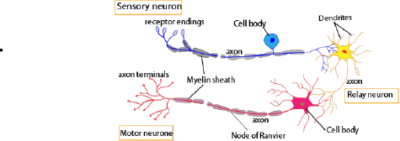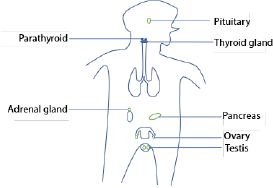
Nervous system -Upper primary science

Coordination and control in animals
Coordination means to cause the part to function together or in proper order.
Coordination and control in animals is performed by the nervous system and endocrine system.
Difference between nervous and endocrine system
| Nervous system | Endocrine system
|
|
| 1. | Fast acting | slow acting |
| 2. | It’s effects are localized | It’s effects are diffuse |
| 3. | Transmission are electrical and Chemical theory cell fibre | Relies on chemical transmission through circulatory system |
| 4. | Transmission occur in nerve | It occurs in blood |
The nervous system.
The nervous system is divided into:-
- The central nervous system (CNS) includes the brainand spinal cord and,
- The peripheral nervous system includes all of the nerves that branch out from the brainand spinal cord and extend to other parts of the body including muscles and organs.
The nerve cells
The nervous system is composed of highly specialized cells called nerve cells or neurons.
Sensory neurons are nerve cells that carry impulses from receptors to the control nervous system.
Effector neurons are nerve cells that carry impulses from the Central Nervous System to effector.

Reflex action and reflex arch.
The reflex action in a rapid, automatic stereotyped response to a stimulus which is not under the conscious control of the brain. It’s also described as involuntary action.
Example of reflex actions
- Rapid withdraw of the arm from a hot object
- Rapid withdraw of the foot from a sharp object.
The neurons forming the pathway taken by the nerve impulse in reflex action is referred to as reflex arch. Illustrated below.

The brain
The brain is swollen anterior end of the vertebrate neural tube which has the over role of the coordination and control of the activities of the whole nervous system.
To accomplish this there are special centers or nuclei in the different parts of the brain for dealing with specific functions such as locomotion, balancing and so on
Functions of the brain
- Receives impulses from receptors
- Integrates these impulses
- Sends out new impulses to the appropriate effect.

Function of the main parts of the brain the human brain.
- The cerebellumcoordinates voluntary movements such as posture, balance, coordination, and speech, resulting in smooth and balanced muscular activity. It is also important for learning motor behaviors
- Pituitary is an endocrine gland that secretes a wide range of hormones controlling such function as water and salt balance, growth, metabolism and sexual development.
- The cerebrum is for initiation of movement, coordination of movement, temperature, touch, vision, hearing, judgment, reasoning, problem solving, emotions, and learning
- Brainstem: acts as a relay center connecting the cerebrum and cerebellumto the spinal cord
- Spinal cord has three major roles:
- to relay messages from the brain to different parts of the body,
- to perform an action, to pass along messages from sensoryreceptors to the brain,
- and to coordinate reflexes that are managed by the spinal cord alone.
- Meninges are membranes that protect the brain and spinal cord
Hormonal communication.
Hormones are organic compounds produced in one part of the body, from which is transported -usually in the blood stream – to another part when it evokes a response.
In the human and other vertebrate hormones are secreted into the blood stream by endocrine glands.
Position of the main endocrine gland in a human body

The principle endocrine glands of mammal, hormones and functions of the hormones
- Pituitary produce hormones that control other endocrine glands
- Ovaries promotes produce estrogens hormones that secondary sexual characteristic of female control menstrual cycle and pregnancy.
- Testis produce androgens that promote development of testes and secondary sexual characteristics
- Pancreas produce insulin that regulates blood sugar concentration
Revision Questions
- Use the diagram below to answer the question which follow.

(a) What name is given to the part labelled P
………………………………………………………………………..…………………………………………………………………..
(b) Give the function of the part marked Q.
………………………………………………………………………………………………………………………………….…………………………………..
(c) Name two sense organs shown in the diagram above, by which someone can tell that there is something burning?
…………………………………………………………………………………………………………………………………………………………………………………………………………………………………………………………………………………….………………
- Give two functions of the nerves in e human body.
………………………………………………………………………………………………………………………………………………………………………………………………………………………………………………………………………………………..
- In which ways is food important in the human body?
…………………………………………………………………………………………………………………………………………………………………………………………………………………………………………………………………………………….
- State the most important part of the nervous system.
……………………………………………………………………………………………………………………………………………
- How is the function of motor nerves different from those of sensory nerves?
………………………………………………………………………………………………………………………………………………………………………………………………………………………………………………………………………………..…………
For revision question download PDF
Sponsored by The Science Foundation College +256 753 802709
Compiled by Dr. Bbosa Science +256 778 633 682

Nice post. I was checking constantly this blog and I’m impressed! Extremely helpful information particularly the last part 🙂 I care for such information much. I was looking for this certain information for a long time. Thank you and best of luck.
You make me see things in a new light. Home & Kitchen
I’m looking forward to more from you! 500 ka redeem code
Your future in medicine begins with MBBS Direct Admission in Manipur.
Explore the latest admission requirements at MBBS Cutoff Of Private Medical Colleges in Tamil Nadu.
Download the Raja Luck App to enjoy seamless gaming on your mobile device.